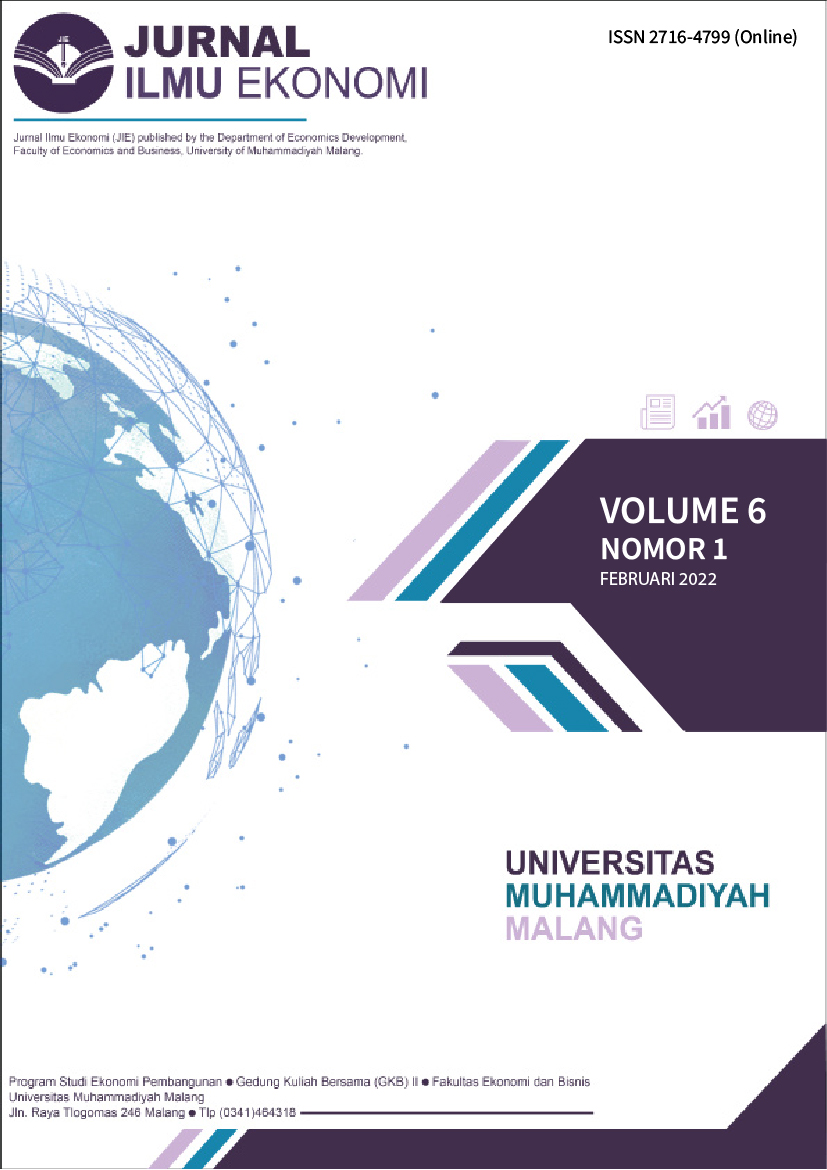Analisis Ketimpangan Ekonomi Dan Sektor Ekonomi Unggulan Di Kabupaten Muaro Jambi Provinsi Jambi
DOI:
https://doi.org/10.22219/jie.v6i1.19092Abstract
The purpose of this study is to determine inequality and the leading economic sector in Muaro Jambi district with a period of 5 years from 2016 to 2020. The research method used is to use the Williamsom index calculation and Static Location Quotient by taking secondary data obtained from sources. Central Bureau of Statistics Muaro Jambi. The results of the study show that inequality is increasing from 2016 to 2020 from the calculation of the Williamson index. Meanwhile, from the calculation of the Static Location Quotient , the leading sectors in Muaro Jambi district are the agriculture, forestry and fishery sectors, processing industry, transportation and warehousing, and other services. The non-leading sectors in Muaro Jambi district are mining and quarrying, electricity and gas supply, water supply, waste management, waste and recycling, construction, wholesale and retail trade, car and motorcycle repair, accommodation and food and drink provision, information and communication, financial and insurance services, real estate, corporate services, government administration, defense and compulsory social security, education services, and health services and social activities.
Downloads
References
Badan Pusat Statistik Muaro Jambi. (2020). Kabupaten Muaro Jambi Dalam Angka 2021. https://muarojambikab.bps.go.id/
Christina, M., & Pratiwi, Y. (2017). Analisis Sektor Unggulan dan Transformasi Struktural di Provinsi Kalimantan Tengah 2010 – 2016. Inovasi Pembangunan : Jurnal Kelitbangan, 5(03). https://doi.org/10.35450/jip.v5i03.44
Fahrizal, Sarfiah, S. N., & Juliprijanto, W. (2019). Analisis ketimpangan ekonomi provinsi jawa tengah tahun 2008-2017. DINAMIC: Directory Journal of Economic, 1(4).
Faturohman, N. R., & Riyanto, W. H. (2020). Analisis Sektor Ekonomi Unggulan di Kota Batu Tahun 2012-2018. Jurnal Ilmu Ekonomi JIE, 4(1). https://doi.org/10.22219/jie.v4i1.6661
Herman Syahputra, A. (2015). Analisis Sektor Unggulan dan Perubahan Struktur Perekonomian Kabupaten Aceh Barat. Jurnal Ilmu Ekonomi, 3(3).
Mardianis, M., & Syartika, H. (2018). Kontribusi Sektor Pariwisata terhadap Pendapatan Asli Daerah di Kabupaten Kerinci. Jurnal Ekonomi & Kebijakan Publik, 09(1), 53–65. https://doi.org/10.22212/jekp.v9i1.972
Noviar, N. (2021). Analisis Ketimpangan dan Klasifikasi Pembangunan Ekonomi Kabupaten/Kota Di Provinsi Banten Tahun 2016-2020. Jurnal Kebijakan Pembangunan Daerah, 5(1). https://doi.org/10.37950/jkpd.v5i1.118
Rachman, I. A. N. (2017). Analisis Sektor Unggulan dalam Perekonomian Kabupaten Malang. Jurnal Ilmiah Mahasiswa FEB, 7(2).
Rasulong, I., & Zaimuddin, M. (2020). Analisis Sektor Ekonomi Unggulan. Jurnal Ekonomi, 16(2), 148–165.
Rinusara, N. M. (2020). Analisis Ketimpangan Ekonomi Wilayah Antar Kabupaten/Kota Di Provinsi Daerah Istimewa Yogyakarta. Skripsi Fakultas Ekonomi Dan Bisnis Jurusan Ilmu Ekonomi. Universitas Brawijaya. Malang.
Soleh, A., & Maryoni, H. S. (2017). Analisis Sektor Ekonomi Unggulan dan Hubungannya dengan Kesempatan Kerja dan Investasi di Kabupaten Batanghari. Jurnal Ekonomi-Qu, 7(1). https://doi.org/10.35448/jequ.v7i1.4183
Sugiyono. (2017). Metode Penelitian Bisnis (Pendekatan Kuantitatif, Kualitatif, Kombinasi dan R&DSugiyono. (2017). Metode Penelitian Bisnis (Pendekatan Kuantitatif, Kualitatif, Kombinasi dan R&D). In Metodelogi Penelitian.). In Metodelogi Penelitian.
Suntari, M. V., & Yunani, A. (2019). Analisis Ketimpangan Pembangunan Ekonomi dan Ketimpangan Distribusi Pendapatan di Provinsi Kalimantan Selatan (Studi Kasus Kota Banjarmasin dan Kabupaten Tanah Bumbu). Ecoplan : Journal Of Economics And Development Studies, 2(2). https://doi.org/10.20527/ecoplan.v2i2.19
Tarigan, & Robinson. (2005). Ekonomi Regional Teori dan Aplikasi (Vol. 29, Issue 14).
Williamson, J. G. (1965). Regional inequality and the process of national development: a description of the patterns. Economic Development and Cultural Change, 13(4, Part 2), 1–84.
Downloads
Published
How to Cite
Issue
Section
License
Copyright (c) 2022 Pambudi, A., Nuraini, I., & Arifin, Z.

This work is licensed under a Creative Commons Attribution-ShareAlike 4.0 International License.
Authors who publish with this journal agree to the following terms:
- For all articles published in the JIE (Jurnal Ilmu Ekonomi), copyright is retained by the authors. Authors give permission to the publisher to announce the work with conditions. When the manuscript is accepted for publication, the authors agree to the automatic transfer of non-exclusive publishing rights to the publisher.
- Authors retain copyright and grant the journal right of first publication with the work simultaneously licensed under a Creative Commons Attribution-NonCommercial-ShareAlike 4.0 International License that allows others to share the work with an acknowledgement of the work's authorship and initial publication in this journal.
- Authors are able to enter into separate, additional contractual arrangements for the non-exclusive distribution of the journal's published version of the work (e.g., post it to an institutional repository or publish it in a book), with an acknowledgement of its initial publication in this journal.
- Authors are permitted and encouraged to post their work online (e.g., in institutional repositories or on their website) prior to and during the submission process, as it can lead to productive exchanges, as well as earlier and greater citation of published work (See The Effect of Open Access).
This is an open access article and licensed under a Creative Commons Attribution-NonCommercial-ShareAlike 4.0 International License








